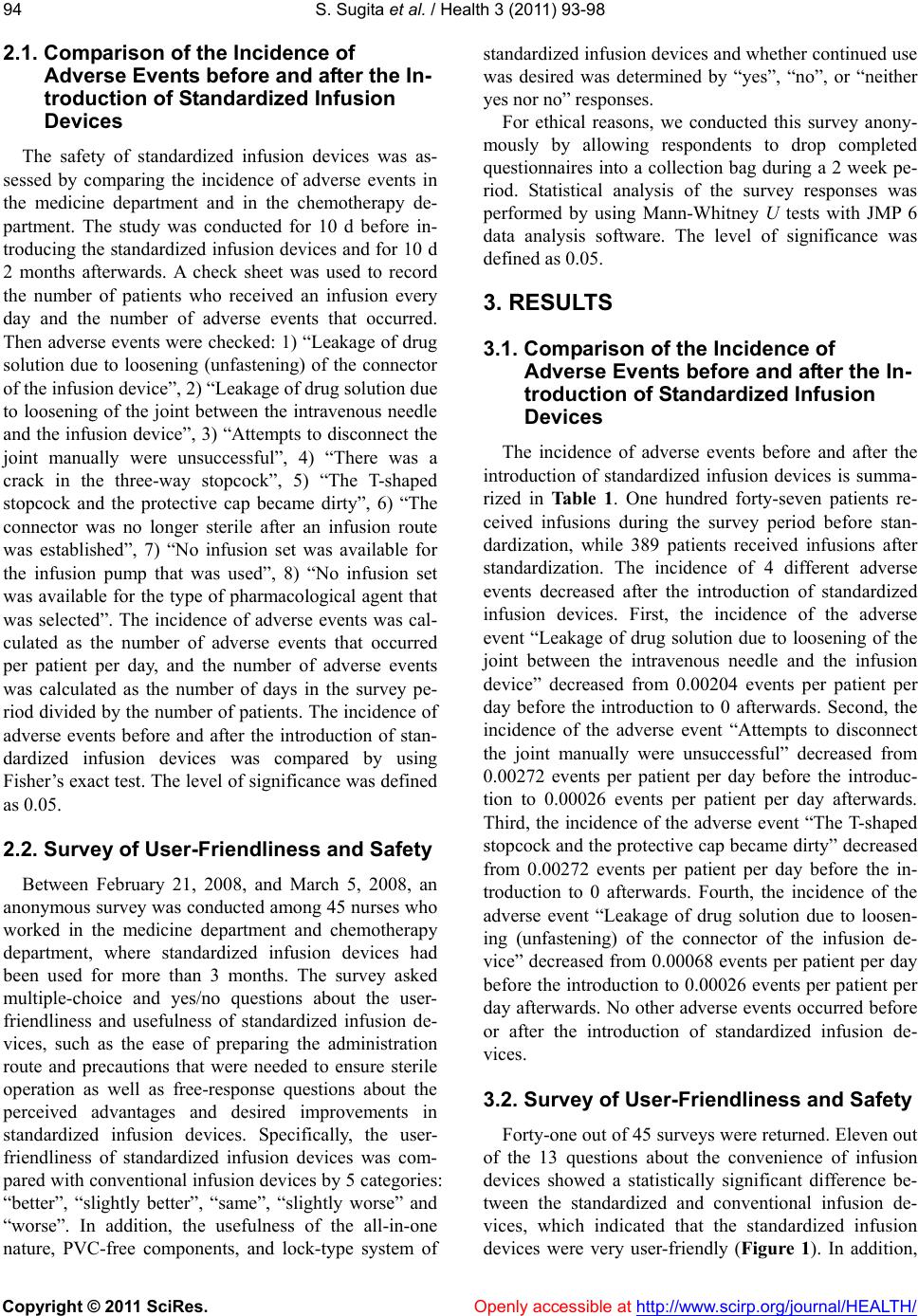
S. Sugita et al. / Health 3 (2011) 93-98
Copyright © 2011 SciRes. Openly accessible at http://www.scirp.org/journal/HEALTH/
94
2.1. Comparison of the Incidence of
Adverse Events before and after the In-
troduction of Standardized Infusion
Devices
The safety of standardized infusion devices was as-
sessed by comparing the incidence of adverse events in
the medicine department and in the chemotherapy de-
partment. The study was conducted for 10 d before in-
troducing the standardized infusion devices and for 10 d
2 months afterwards. A check sheet was used to record
the number of patients who received an infusion every
day and the number of adverse events that occurred.
Then adverse events were checked: 1) “Leakage of drug
solution due to loosening (unfastening) of the connector
of the infusion device”, 2) “Leakage of drug solution due
to loosening of the joint between the intravenous needle
and the infusion device”, 3) “Attempts to disconnect the
joint manually were unsuccessful”, 4) “There was a
crack in the three-way stopcock”, 5) “The T-shaped
stopcock and the protective cap became dirty”, 6) “The
connector was no longer sterile after an infusion route
was established”, 7) “No infusion set was available for
the infusion pump that was used”, 8) “No infusion set
was available for the type of pharmacological agent that
was selected”. The incidence of adverse events was cal-
culated as the number of adverse events that occurred
per patient per day, and the number of adverse events
was calculated as the number of days in the survey pe-
riod divided by the number of patients. The incidence of
adverse events before and after the introduction of stan-
dardized infusion devices was compared by using
Fisher ’s exact test. The level of significance was defined
as 0.05.
2.2. Survey of User-Friendliness and Safety
Between February 21, 2008, and March 5, 2008, an
anonymous survey was conducted among 45 nurses who
worked in the medicine department and chemotherapy
department, where standardized infusion devices had
been used for more than 3 months. The survey asked
multiple-choice and yes/no questions about the user-
friendliness and usefulness of standardized infusion de-
vices, such as the ease of preparing the administration
route and precautions that were needed to ensure sterile
operation as well as free-response questions about the
perceived advantages and desired improvements in
standardized infusion devices. Specifically, the user-
friendliness of standardized infusion devices was com-
pared with conventional infusion devices by 5 categories:
“better”, “slightly better”, “same”, “slightly worse” and
“worse”. In addition, the usefulness of the all-in-one
nature, PVC-free components, and lock-type system of
standardized infusion devices and whether continued use
was desired was determined by “yes”, “no”, or “neither
yes nor no” responses.
For ethical reasons, we conducted this survey anony-
mously by allowing respondents to drop completed
questionnaires into a collection bag during a 2 week pe-
riod. Statistical analysis of the survey responses was
performed by using Mann-Whitney U tests with JMP 6
data analysis software. The level of significance was
defined as 0.05.
3. RESULTS
3.1. Comparison of the Incidence of
Adverse Events before and after the In-
troduction of Standardized Infusion
Devices
The incidence of adverse events before and after the
introduction of standardized infusion devices is summa-
rized in Table 1. One hundred forty-seven patients re-
ceived infusions during the survey period before stan-
dardization, while 389 patients received infusions after
standardization. The incidence of 4 different adverse
events decreased after the introduction of standardized
infusion devices. First, the incidence of the adverse
event “Leakage of drug solution due to loosening of the
joint between the intravenous needle and the infusion
device” decreased from 0.00204 events per patient per
day before the introduction to 0 afterwards. Second, the
incidence of the adverse event “Attempts to disconnect
the joint manually were unsuccessful” decreased from
0.00272 events per patient per day before the introduc-
tion to 0.00026 events per patient per day afterwards.
Third, the incidence of the adverse event “The T-shaped
stopcock and the protective cap became dirty” decreased
from 0.00272 events per patient per day before the in-
troduction to 0 afterwards. Fourth, the incidence of the
adverse event “Leakage of drug solution due to loosen-
ing (unfastening) of the connector of the infusion de-
vice” decreased from 0.00068 events per patient per day
before the introduction to 0.00026 events per patient per
day after wards. No other adve rse events o ccurred before
or after the introduction of standardized infusion de-
vices.
3.2. Survey of User-Friendliness and Safety
Forty-one out of 45 surveys were returned. Eleven out
of the 13 questions about the convenience of infusion
devices showed a statistically significant difference be-
tween the standardized and conventional infusion de-
vices, which indicated that the standardized infusion
devices were very user-friendly (Figure 1). In addition,